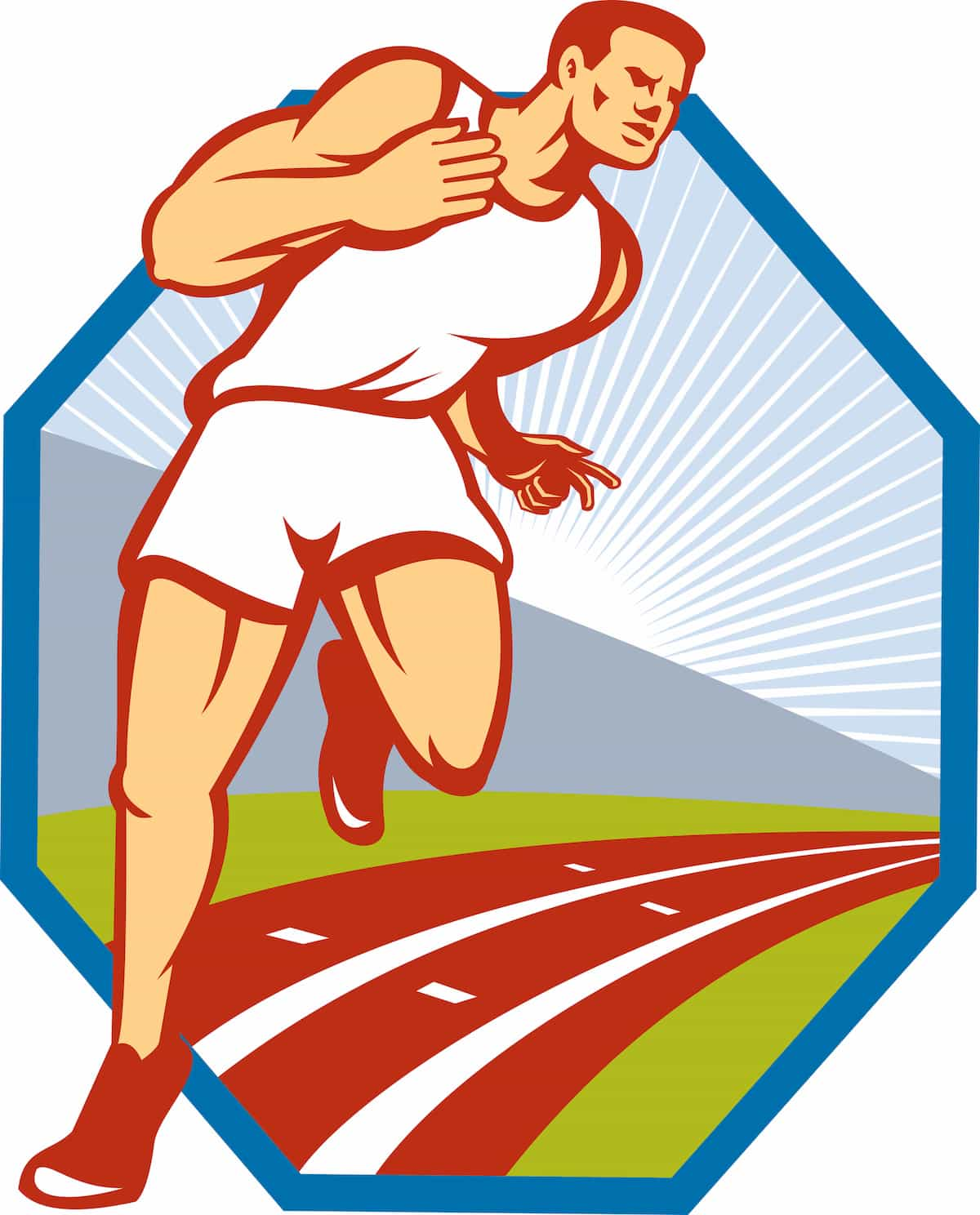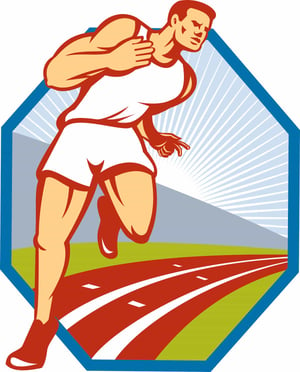Track and Field: What you need to know regarding risks and injuries
June 12th, 2019 | 4 min. read

What is Track and Field? Track and Field is a sport which pulls together a multitude of high energy events such as running, jumping, and throwing. As the name suggests, events take place both on the track and on the Field. Events range from short sprints, mid sprints, middle distance, long distance, jumping, throwing, and pole vaulting. There are also events which combine all events across the board known as the heptathlon and decathlon.

Within each Track and Field event brings with it different challenges mentally, physically, and training wise. While sprinting events deal with short high-intensity impacts to their lower body, throwers deal with high-intensity twisting forces, distance runners deal with repetitive motion injuries, and jumpers deal with high-intensity impacts. While this is oversimplified, it does highlight some differences in the forces at play.
While Track and Field can be demanding physically from impacts and intense motions at play, facts such as extreme heat, cold, and lack of proper hydration can be at play, especially in the lower levels without experience. In any aspect of Track and Field athletes are competing at the highest end of their physicality and physical injuries aside, this can create a bad environment for those pushing to their greatest extent in adverse conditions. Ricks can include heat stroke and strains and pulls as well as asthmatic symptoms.
All of this doesn't change the fact that there is something inherently fun about competing head to toe with worthy competitors. Track and Field is at the heart of all completive sports and at its rawest form, no balls, no diverting to a teammate, or breaks. Track and Field is non-stop, which makes competing and or winning that much better.
As with recreational running, the tight competition isn't the only thing that makes running fun. Running is very much a social sport with teammates and training partners. How do you think they stay entertained through all of their training. Great teammates are what makes the sport so enjoyable. The team aspect doesn't just stop with training partners. While most people think that running is a solo sport, teams depend on everyone to work together to rally points to win. Some people might also be familiar with the 4x100, 4x200, 4x400, DMR these are very team dependent requiring every leg within the relay to perform their best and handoff in an efficient way.
Although some aspects of the sport make it challenging and enjoyable, they also make it rough on a runner's body, at any age. High school runners, college runners, and adult runners all need to be aware of the risks of injury that come with running cross country.
Risks of Competing in Track and Field
What injuries most commonly affect athletes running, jumping and throwing in Track and Field, at the middle school level, high school level and beyond?
Below is a list of some of the more common injuries seen in Track and Filed of all ages. Note this list is merely most common and not a comprehensive.
-
Stress fractures.
Are common among mid-distance and distance track athletes. Stress fractures are overuse injuries that often occur in the weight-bearing bones of the lower body. Over long runs, muscles become fatigued, and the impact forces from pounding feet against the ground get transferred from muscle to bone. Stress fractures often develop in the shin bones and feet due to repeated stress and force over time.
-
Shin splints (medial tibial stress syndrome, or MTSS).
This running injury is also more common in mid-distance and distance athletes but can be very present across all track athletes as short repeated high-intensity sprints can bring these out as well as high intensity jumps. It is typically caused by overtraining in a short period. Shin splints is a term used to describe throbbing pain in the anterior (front) of the lower legs. Shin splints are not stress fractures, though they are often confused for them.
-
Achilles tendonitis.
Athletes, particularly runners and jumpers, often strain or even tear or rupture an Achilles tendon when making intense pushing-off movements. Tight calf muscles and poor choice of footwear often contribute to this injury. -
Plantar fasciitis.
Plantar fasciitis is an overuse injury affecting the arch of the foot. Repeated, tiny tears in the fascia that runs alongside the bottom of the foot can lead to inflammation and pain. These are common in long-distance runners, as these tears don't get a chance to heal. The result: soreness and stiffness along the bottom of the foot, especially when walking or running after a period of rest. As you move around, the stiffness and pain subside, but symptoms return daily until the injury heals. -
Runner’s knee
(patellofemoral pain syndrome, or PFPS). This overuse injury involves friction that wears down the cartilage in the knee, ultimately leading to osteoarthritis. Runner's knee presents as pain in, around, or behind the kneecap. Runner's knee is common among steeplechase athletes. The knee may feel stiff and sore when standing after resting or sitting for long periods.
-
ACL Anterior cruciate ligament (ACL), Posterior cruciate ligament (PCL) Tears
These can be mild, small, to severe tears (sometimes called a rupture), avulsion – These are more prevalent in jumpers and throwers due to their high impact and twisting motions. Tares Located in the center of the knee, the ACL controls rotation and forward movement of the shin bone — for example, when kicking or taking a forward step.
-
Dehydration and heat illness.
Hydration is critical for all athletes, especially any athlete practicing a sport in our high Texas heat. Staying hydrated protects cartilage and prevents soft tissue injury. It also prevents heat illness. During your race, you can't carry water, but you should make sure to hydrate before and after your run to keep your fluid levels steady. Replace all lost fluids immediately after your run. Stay out of the sun when possible, and wear sunscreen. Heat illness is a severe and dangerous condition that can be deadly. If you see the signs of heat cramps, syncope, heat exhaustion or heat stroke in yourself or teammates, tell a friend or coach and immediately take measures to hydrate, get out of the sun, and get into a cooler environment.
Preventing Cross Country Running Injuries
How can you prevent cross country running injuries? The best ways for outdoor runners to stay healthy include the following running tips:
-
Stretch daily.
For all runners and athletes, a regular stretching regimen is an important part of conditioning. Both static and dynamic stretches are needed to keep your bones, joints, muscles, ligaments and tendons healthy. -
Warm up and cool down.
Muscles and tendons are less likely to overstretch or tear if they’ve been properly prepared for running and racing. High-intensity workouts like training and racing require more prep and post-workout cooldown than low-impact activities. -
Wear the right shoes.
Make sure your shoes fit properly, that they are neither too snug nor too loose. Tie double-knots to prevent tripping over undone laces. If an orthopedist tells you that you need special inserts like orthotics or gel soles, use them. Break your shoes in before race day, and replace them regularly (after every 300 miles). -
Eat and drink enough.
Competitive distance runners like to keep their weight low. However, consuming too few calories can harm your body, especially if you’re a girl or woman subject to the female athlete triad. Eat a well-balanced diet and be sure to stay well-hydrated to prevent injury and heat illness. Remember that in Texas, especially in full sun or in humid regions of the state, you’re particularly prone to heat stroke. Drink plenty of water before and after running.
Dr. Williams has been practicing orthopedic surgery in Corpus Christi since 1998. After graduating from Texas Tech hereceived his medical degree from the University of Texas at San Antonio. At the prestigious Campbell Clinic located at the University of Tennessee, Dr. Williams completed not only an Orthopedic Surgery Residency, but an additional year of Fellowship Training in Spine Surgery. Dr. Williams is dedicated to creating an excellent patient experience in the office or in the surgery suite.
Topics:
